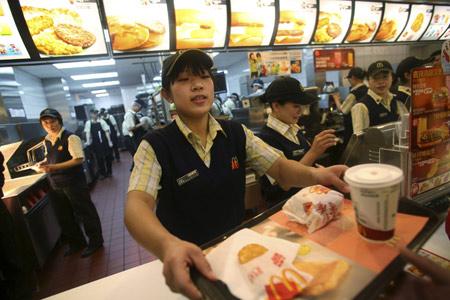 A McDonald's employee serves a customer at an outlet of the fast food chain in Beijing. [Photo/Agencies]
A McDonald's employee serves a customer at an outlet of the fast food chain in Beijing. [Photo/Agencies]BEIJING - It is late at night in Beijing and Han Liang is at his small restaurant long after his last customers have left, waiting for a sanitation worker to remove the waste.
"I never ask his name, although he has been coming for our garbage every day for about a year," Han said. The only thing he knows about that man is that he is a farmer and uses the restaurant refuse to feed his pigs.
"He pays me 200 yuan ($30) each month for the garbage," Han said. His restaurant produces 100 kilograms of waste every day on average, and a little more in summer.
China's big cities such as Beijing and Shanghai do not have a transparent garbage treatment cycle. That is why there have been many scandals involving polluted cooking oil in recent years. Because restaurant waste can be easily collected by individuals, three million tons of dirty oil refined from the waste and infused with poisonous carcinogens have been returned to dining tables through an underground network.
China produces 60 million tons of restaurant garbage annually with no supervision as to where it goes, according to data from Tsinghua University. In Beijing alone, the capital city produces 1,200 tons of restaurant waste every single day, according to the Beijing municipal commission of development and reform.
"Although there are regulations forbidding the use of swill-cooked oil, the benefit chain is still there," said Gongsun Wei, director of the newly founded National Restaurant Garbage Processing Technology Promotion Office. "To cut the chain is our priority. For the second step, we have designed a total circle to transform the garbage into many useful goods, such as bio-diesel oil, commercial grease, marsh gas and organic fertilizer."
According to Gongsun, China's first model city for the treatment of restaurant waste, Lanzhou, the capital of Gansu province in Northwest China, goes into operation this month.
Lanzhou has a population of three million and produces 200 tons of restaurant garbage every day. "Our annual output of goods will be 15.33 million kilowatt-hours of electricity, 3,000 tons of commercial grease, 7.67 million cubic meters of marsh gas and 4,161 tons of organic fertilizer," said Bao Lin, chairman of CNBioenergy Ltd, which runs the technology part of the pilot project.
CNBionergy trucks fitted with hermetically-sealed garbage barrels, which can be tracked through an electronic label, collect the waste in Lanzhou and transport it to a treatment plant for zymolysis, a process involving the fermentation activity of enzymes.
"Unlike some already existing garbage power plants which burn household garbage, we use zymolysis on restaurant waste because it contains too much water to burn," said Bao.
Gongsun said: "To be honest, I'm not sure if this will be profitable, but it will be popular at a time when everyone is aware of the importance of an eco-friendly society."
As the founder of the company, Bao put his own money 10 years ago into waste treatment research and development. Now his company has 22 patents for inventions and technology, especially on anaerobic fermentation. In 2006, CNBioenergy set up a joint venture with German company BTA Biotechnische Abfallverwertung GmbH & Co KG, which has expertise in the field of garbage re-use.
"We are also talking with the International Finance Corporation of the World Bank Group for financial support," said Gongsun, who is also the training director at Beijing's "Mayor's Home", a training center for mayors from around China. "We try hard to promote this project to more than 100 mayors. If everything goes well, our plan will come to Beijing and Shanghai in three to five years."
"The cities who want to join us don't need to afford the whole 120 million yuan cost up front by themselves. They can pay as little as 30 percent, then apply for loans. Also, many venture capitalists have shown a lot of interest in this field."
Gongsun added that he saw a report in the Guangzhou-based Nanfang Daily newspaper that Goldman Sachs invested in a garbage power company in Beijing this year.
There are two main problem areas for restaurant garbage treatment companies. One is the technology and the other is government support.
In Japan, where swill-cooked oil appeared in the 1960s, the government paid a high price to buy food waste from each family and hotel. Now every garbage collecting truck in Japan uses fuel that is generated from the waste. In this way, the Japanese people are happy to provide their waste to the government and pirate refiners cannot get their hands on it.
Other developments may also emerge. According to the Science American magazine, US scientists invented a new technology that can turn swill-cooked oil into a liquid polymer for use as oil-based paint on roofs.





